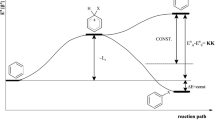Abstract
A new approach to revealing a relationship between various physicochemical properties of organic compounds is suggested. The basic principle of this approach consists in that deviations of experimental values of various molecular parameters from linear dependences for the constituent elements are due to intramolecular forces of the same nature.
Similar content being viewed by others
References
Stine, J.R., J. Energetic Mater., 1990, vol. 8, pp. 41–49.
Piacenza, G., et al., 30th Int. Ann. Conf. Energ. Mater., Carlsruhe, FRG, 29 June–2 July 1999, Carlsruhe, 2000, pp. 123/1–123/14.
Tarver, C.M., J. Chem. Eng. Data, 1979, vol. 24, no. 2, pp. 136–145.
Immirizi, A. and Perini, B., Acta Cryst., 1977, vol. 33, pp. 216–218.
Sikder, A.K., Maddala, G., et al., J. Hazardous Mater., 2001, vol. A84, pp. 1–26.
Kotomin, A.A. and Kozlov, A.S., Metod rascheta plotnosti organicheskikh soedinenii po vkladam fragmentov molekul: Uchebnoe posobie (Method for Calculation of the Density of Organic Compounds from the Contributions of Molecular Fragments: Manual), St. Petersburg: SPb. Gos. Tekhnol. Inst. (Tekhnol. Univ.), 2005.
Egorova, L.F. and Gidaspov, A.A., Eksperimental’nyi i raschetnye metody opredeleniya ental’pii obrazovaniya vzryvchatykh veshchestv (Experimental and Calculational Methods for Determining the Enthalpy of Formation of Explosives), Kuibyshev: Kuibysh. Polytekhn. Inst., 1984.
Potapov, A.A., Deformatsionnaya polyarizatsiya (Deformation-induced Polarization), Novosibirsk: Nauka, 2004.
Gussoni, M., Rui, M., and Gerbi, G., J. Mol. Struct., 1998, vol. 447, pp. 163–215.
Miller, K.J., J. Am. Chem. Soc., 1990, vol. 112, pp. 8533–8543.
Miller, K.J. and Savchik, J.A., J. Am. Chem. Soc., 1979, vol. 101, no. 24, pp. 7206–7213.
Denbigh, K.G., Trans. Faraday Soc., 1940, vol. 36, pp. 936–948.
Vogel, A., J. Chem. Soc., 1948, pp. 1833–1855.
Luzanov, A.V., Zh. Strukt. Khim., 2003, vol. 44, no. 4, pp. 743–747.
Egorochkin, A.N., Voronkov, M.G., Zderenova, O.V., and Skobeleva, S.E., Izv. Akad. Nauk, Ser. Khim., 2001, no. 1, pp. 41–47.
Egorochkin, A.N., Voronkov, M.G., Skobeleva, S.E., and Zderenova, O.V., Izv. Akad. Nauk, Ser. Khim., 2001, no. 1, pp. 34–40.
Politzer, P., Jin, P., and Murray, J.S., J. Chem. Phys., 2002, vol. 117(18), pp. 8197–8202.
Zevatskii, Yu.E., Zh. Prikl. Khim., 2005, vol. 78, no. 3, pp. 466–470.
Sam P. de Visser, Phys. Chem. Chem. Phys., 1999, vol. 1, pp. 749–753.
Novyi spravochnik khimika i tekhnologa (New Reference Book for Chemists and Technologists), Skvortsov, N.K., Ed., St. Petersburg: NPO Mir i Sem’ya, 2002.
Khimicheskaya entsiklopediya (Chemical Encyclopedia), Knunyants, I.L., Ed., Moscow: Sovetskaya Entsiklopediya, 1988, vols. 1, 2.
CRC Handbook of Chemistry and Physics, Lide, D.R., Ed., Boca Raton, Florida, 2002, Section 10, pp. 162–173.
NIST Chemistry WebBook. NIST Standart Reference Database, June 2005, no. 69.
Energii razryva khimicheskikh svyazei: Potentsialy ionizatsii i srodstvo k elektronu: Spravochnik (Rupture Energies of Chemical Bonds: Ionization Potentials and Electron Affinity), Kondrat’ev, V.N., Ed., Moscow: Nauka, 1974.
Comprehensive Heterocyclic Chemistry: Review of Literature 1982–1995: the Structure, Reactions, Synthesis, and Uses of Heterocyclic Compounds, Katritzky, A.K., Ed., Oxford, 1996, vol. 3.
Author information
Authors and Affiliations
Additional information
Original Russian Text © Yu.E. Zevatskii, S.S. Lysova, 2006, published in Zhurnal Prikladnoi Khimii, 2006, Vol. 79, No. 6, pp. 978–985.
Rights and permissions
About this article
Cite this article
Zevatskii, Y.E., Lysova, S.S. Relationship between the molar volume and enthalpy of formation, polarizability, and ionization potential of CHNO-containing organic substances. Russ J Appl Chem 79, 967–974 (2006). https://doi.org/10.1134/S1070427206060188
Received:
Issue Date:
DOI: https://doi.org/10.1134/S1070427206060188




